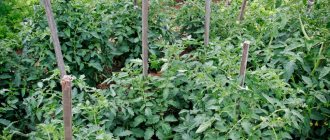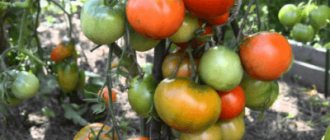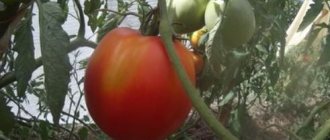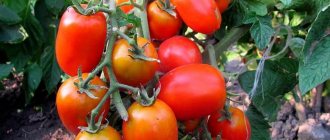In the summer-autumn period, it is difficult to imagine a dinner table without tomatoes. This vegetable is a delicacy for most of our compatriots, so vegetable growers are not lazy to tinker with seedlings and care for plants in open beds or greenhouses.
Today, many summer residents prefer to grow tall tomatoes on their plots. Indeterminate tomato bushes grow continuously, producing many clusters of flowers and exhibiting high yields. At the same time, summer residents can receive tasty and healthy vegetables throughout the summer and autumn, right up to the onset of frost. In greenhouse conditions, this crop produces a harvest even longer. One of the brightest representatives of indeterminate varieties is the hybrid tomato Kibo F1, reviews, productivity and cultivation features of which we will consider later in the article.
F1 hybrids
F1 tomatoes are obtained by crossing selected parent varieties with specified characteristics: yield, resistance to various diseases, keeping quality, transportability, resistance to high and low temperatures, setting in low light, etc. The cost of F1 tomato seeds, of course, is several times higher than the price of varietal tomatoes, but if you take into account all the advantages of hybrids (increased productivity, reduced processing costs, reduced losses during storage and transportation, attractive appearance), then the cost of purchasing seeds is well worth it.
Harvest and use
The first tomatoes begin to ripen 100–110 days after germination, and after 1.5–2 weeks mass fruiting begins. Kibo fruits, carefully collected and placed in shallow containers, can withstand even long-term transportation without compromising their appearance or taste. Can be stored for up to 3 months (if collected unripe). Thanks to the combination of juiciness and meatiness of the pulp, these tomatoes are good both in salads and in home canned food.
Kibo fruit makes excellent juice
Description of tomato Kibo F1
The hybrid was bred in Japan by Kitano Seeds. This is a very large indeterminate pink tomato of early ripening. The variety is recommended to be grown in any type of greenhouse. The root system of the plant is highly developed and is not afraid of stressful situations such as, for example, a sharp change in temperature. The culture forms fairly powerful shoots, which can grow up to 5-6 large fruits that meet all the requirements for the marketability of pink tomatoes. The bush itself is quite tall, reaching a height of up to 2 m, which allows you to significantly save space in greenhouses and use free space more efficiently. Thanks to the long growth period, farmers do not need to constantly renew the plantings in the garden.
One hybrid indeterminate bush can produce several times more tomatoes than a low-growing bush. And due to the constant growth and production of buds, continuous ovary and rapid formation of fruits occurs. Kibo F1 tomatoes received good reviews from agronomists. They noted the excellent taste of the fruit and wide consumer demand.
Diseases and pests
The Kibo F1 variety is a relatively stable vegetable crop, but in the absence of proper care it can be affected by the following diseases:
- Streak. The disease can be recognized by the presence of yellow spots in the form of stripes on the fruit and stem. As a result, the leaves curl and wither. Flowers and fruits fall off. If the lesion is extensive, then remove the diseased bush from the soil and destroy it. To prevent the development of the disease, you need to normalize the lighting and not place plants too close to each other.
- Verticillium wilt. The lower leaves on diseased bushes turn yellow, wither and fall off. Affected plants are inhibited in growth and development. Brown outlines of blood vessels are formed on the cut of stems and petioles. To prevent the disease, introduce fertilizing in a timely manner to increase the resistance of tomatoes to infection.
- Late blight. Brown or brown spots of unknown shape form on leaves, stems and fruits. Over time, the affected part of the fruit increases. For prevention, follow the rules of crop rotation and apply phosphorus-potassium compounds. The drugs used are Barrier and Barrier.
Among the pests that remain dangerous are:
- Whitefly. The parasite has two pairs of white wings, small in size. As a result of its vital activity, yellow spots form on the leaves, causing them to wither. The pest covers the tomatoes with sticky mucus, on which fungi multiply. The drug Confidor is used for control.
- Spider mite. This is a small parasite that is visible on tomatoes as a light dot. Covers the leaf blade with a thin web and sucks out the juice. Punctures are noticeable on the outside, causing the leaves to dry out. To combat, use Karbofos or garlic infusion with the addition of liquid soap.
Description of fruits
Kibo F1 tomatoes, reviews and cultivation features of which we discuss in the article, are distinguished by beautiful pink large fruits and are very popular in the vegetable market. The average weight of marketable fruits is 300-350 g, and those grown on the first cluster - up to 450 g. The surface of the tomatoes is smooth, without ribs. The shape is beautiful, smooth, without “figures”. The tomato is round, slightly flattened near the stalk. The color is uniform - pink, very bright, without green spots. The pulp has a homogeneous structure: without a white core and veins. The fruits are distinguished by high taste characteristics, decent presentation and excellent transportability.
Pros and cons of indeterminate tomatoes
- This variety has many positive qualities, which in turn ensure good productivity. One of its bushes can produce much more fruit than an ordinary low-growing one.
- The plant grows upward, which saves space and makes it possible to properly dispose of them. If tomato growth occurs in a greenhouse, there is no need to renew the plantings, since they have a long cycle.
See also
Description of the tomato variety Alice, features of cultivation and careRead
Disadvantages:
- If the summer period is short, then growing this variety in open ground is impossible.
Tomatoes Kibo F1: reviews from agronomists
This variety has many advantages. According to reviews, Kibo F1 tomatoes are different:
- Good fruit set.
- High yield. There can be 5-6 fruits on one brush.
- Early ripening of tomatoes.
- The absence of green veins near the stalk.
- Pleasant sugary taste of the fruit.
- High marketability.
- Transportability.
In addition, Kibo tomatoes, reviews of which we are reviewing, do not crack under intensive watering and have high immunity to various diseases. The variety is resistant to temperature changes and tolerates dry periods well.
Feedback from agronomists is that this indeterminate hybrid is the leader among other pink tomato varieties. Thanks to their excellent taste, preservation of excellent presentation during long-term transportation and increased demand among buyers, Kibo tomatoes have won recognition among specialists.
History of growing the Kibo hybrid
The Kibo F1 hybrid appeared thanks to the efforts of breeders from the largest international company of Japanese origin, Kitano Seeds. The hybrid is also known under the operating number KS 222 F1.
Despite the popularity of the tomato in European countries and positive reviews from Russian and Ukrainian gardeners, Kibo has not yet been included in the State Register.
Since the hybrid is intended mainly for cultivation in greenhouses, it can be cultivated in almost any region.
Planting and care
Kibo F1 tomatoes are intended exclusively for growing in greenhouses and greenhouses. Seedlings grown in containers are planted in a permanent place at the age of 60-65 days. Flowering of the bushes begins after 10-12 leaves bloom. The ripening period of this tall hybrid is 100-110 days of growing season. The period of active fruiting begins in about two more weeks.
Caring for the indeterminate tomato variety Kibo F1 is quite simple:
- In case of strong growth of the bush or partial (complete) death of the lower foliage, it is necessary to trim unsuitable or excess green mass.
- When watering, you need to disperse the stream of water so that the pressure does not wash away the soil around the plant. Otherwise, the tomato bush may not receive the necessary nutrients and mineral fertilizers absorbed by the adventitious roots.
- To prevent fungal diseases, tomatoes are treated with preparations containing large amounts of sulfur and copper.
Since this is an indeterminate variety of tomatoes with tall stem growth, it requires special supports in the greenhouse. To do this, place trellises, install large pegs or attach an agricultural mesh and then tie plants to them. Normal lighting and good ventilation contribute to the rapid ripening of fruits. This unique method of growing tall tomatoes on a support protects vegetables from rotting and parasites, since they do not come into contact with the soil. Tying minimizes the risk of plant damage from rodents, bollworms and slugs.
Features of cultivation
In order for the harvest to be good, you should keep this in mind.
Planting seeds
Planting work begins in mid-February. From the moment the first shoots form until the plants are transferred to the greenhouse, 1.5-2 months should pass.
Procedure:
- Prepare the soil for planting at home. To do this, combine garden soil, peat and humus in equal proportions.
- Place the substrate in a box 10 cm high.
- Prepare the seed material by soaking it in warm water for a day.
- Planting material is sent into furrows to a depth of 1 cm. The distance between them is 5 cm, and between rows - 10 cm.
- Cover the box with polyethylene and place it in a dark and warm place.
- After 7-10 days, the first shoots appear. At this time, move the containers to a sunny place. If daylight hours are short, then install lamps above the seedlings. The lighting duration will be 12 hours.
- If the weather is sunny, then irrigate the seedlings daily. Apply fertilizing at intervals of 10 days. For fertilizer, take 1 liter of water, dissolve 1 g of nitrate, 2 g of potassium sulfate and 3 g of superphosphate.
Planting seedlings
Prepare soil for tomatoes in the fall. Remove the top layer, as parasite larvae and fungal spores may remain in it. Treat the renewed soil with a solution of copper sulfate (20 g of substance per 10 liters of water). Dig up the beds and add humus. After this, close the greenhouse for the winter.
For Kibo F1 tomatoes, land where legumes, pumpkins, cucumbers and onions previously grew is perfect.
Procedure:
- Transplanting seedlings should take place on a cloudy day or in the evening, when there is no direct exposure to sunlight.
- Prepare holes 15 cm deep. Place them at a distance of 60 cm.
- It is better to plant seedlings in a checkerboard pattern.
- After planting, water the plants thoroughly.
Further care
When planting Kibo F1 tomatoes in a permanent place, they require careful care. It consists of the following:
- Watering . Kibo F1 needs moderate moisture. With a lack of moisture, the plant grows and develops slowly, which negatively affects the yield. But excess moisture is the main cause of root rot and the development of fungal diseases. Pour up to 2 liters of water under each bush. Watering should be done 1-2 times a week. Warm water is used, applied only at the root.
- Fertilizer. The applied fertilizers activate the growth of vegetable crops and increase productivity. Feed Kibo F1 tomatoes 3-4 times per season. Use natural and mineral compositions. If the seedlings are weak and not sufficiently developed, then add nitrogen fertilizers. These include ammonium nitrate and mullein. But you shouldn’t get carried away with them, as this will lead to the formation of abundant greenery.
- Garter and stepson . Since the Kibo variety is tall, garter it as it grows. Start doing this when the height of the bushes reaches 40 cm, using wooden supports. Arrange them in arcs opposite each other, and stretch a rope between them. Stepping helps to get rid of excess shoots. The Kibo variety is prone to overgrowth, so remove side shoots every week. Then the vegetable crop will direct all its forces to the formation of fruits.
Advantages and disadvantages, features, differences from other varieties
A special feature of the Kibo hybrid is its beautiful large fruits and the possibility of growing them in “extended rotation”. This tomato was bred for greenhouses, working even in winter. The possibility of winter cultivation is guaranteed, among other things, by the hybrid’s low need for natural light. Thus, it turns out that it should be more valuable for commercial use than for amateur gardeners.
The advantages of the Kibo tomato are:
- very high yield;
- independence of fruit set from external conditions;
- resistance to changes in temperature and humidity;
- excellent presentation of the fruit;
- good transportability and preservation of the crop;
- no cracking of tomatoes;
- resistance to most diseases.
Disadvantages include:
- impossibility, in most regions, of growing in open ground;
- high cost of seed material.
It is difficult to compare the Kibo tomato with other currently available varieties: on the one hand, their number has long exceeded a thousand, on the other, most of the available ones are mainly intended for use in personal gardens. There are not many tomatoes for winter greenhouses; their demand among summer residents is low. The comparison is also complicated by the lack of registration of the hybrid in the State Register of the Russian Federation: the reason for this is not entirely clear, because it includes many foreign developments.
For some reason, the State Register of the Russian Federation generally ignores tomatoes from Kitano Seeds, although it contains many developments by Dutch, French, Israeli and other foreign corporations
At the same time, it is quite possible to pay attention to a number of Japanese hybrids, and the Kibo tomato is one of the best on this list: the developer himself considers it “the standard of quality for pink tomato” and calls it the leader in consumer demand, especially highlighting the excellent transportability and resistance of plants to stress situations
Characteristics of the variety
Kibo tomato yield
The bushes of this variety are distinguished by a large number of positive characteristics, which are the reason for their excellent productivity. Just one stem can produce about 5-6 tomatoes, making it superior to the regular low-growing variety of tomatoes.
Due to the long growth of the tomato, fruits can be obtained for a long time without planting updates.
Area of application of fruits
Kibo F1 tomatoes can be consumed raw, canned, and also subjected to all kinds of culinary treatments. Tomatoes of this type make excellent juices, sauces and marinades. They are also an indispensable ingredient in dishes such as stew, salad, pizza, soup, etc. Due to the high level of acids in these vegetables, tomatoes go well with meat.
Resistance to diseases and pests
Tomatoes of this type have a very strong immune system. They are resistant to various diseases and pests, which often affect many varieties of tomatoes.
Advantages and disadvantages of the variety
Kibo tomatoes have a lot of positive qualities:
- Vegetables are resistant to pests and various types of diseases.
- There are no greenish areas on the skin of the fruit near the stalks.
- Tomatoes can be stored for a long time.
- Tomatoes can withstand long-term transportation without any problems.
- The Kibo tomato variety has a high yield (approximately 10 kg of tomatoes per 1 m2).
- The fruits are universal in consumption.
- Vegetables have excellent taste and presentation.
- Thanks to the high growth of the stems, you can significantly save space.
Despite all the advantages, this type of tomato has one significant drawback - it cannot be grown in open soil in a climate zone characterized by a short summer period.











